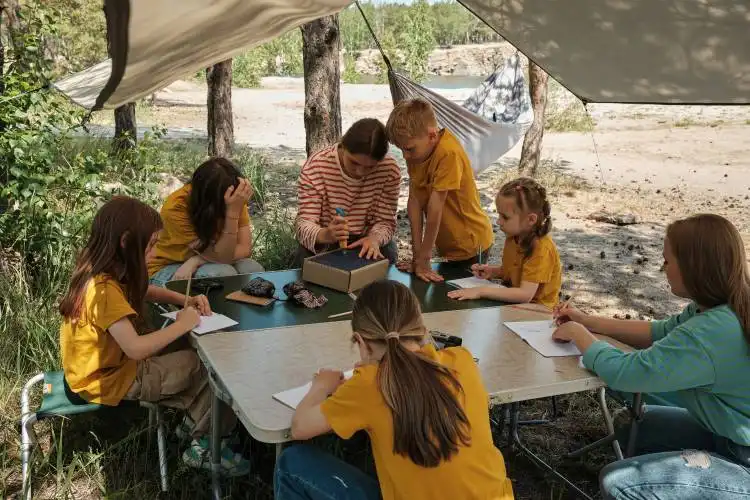Start a Horseback Riding Lessons Business
Galloping Towards Profit: The Equestrian Entrepreneur's Guide
| Updated


HORSEBACK RIDING LESSONS BUSINESS
Mount up on a high-profit, fun-filled venture with a Horseback Riding Lessons Business! As an entrepreneur, you'll be combining your passion for horses with an opportunity to impart equestrian skills to others. In essence, this business affords you the privilege of teaching aspiring young jockeys, horse enthusiasts, and leisure riders the art of saddling up, riding with charisma, and bonding seamlessly with these majestic creatures. Ride on the trails of profit while teaching others how to enjoy the pure, windy thrill of horseback riding.
Jump to Business Plan
RELATED BUSINESS IDEAS
Browse ALL Education & Learning Platforms Business Ideas
Discover Your Perfect Domain
Unlock the door to your online success with our hand-picked selection of premium domain names. Whether you're starting a new venture or rebranding an existing one, the right domain can set the tone for your digital presence. Browse through our curated list, each with its unique potential to enhance your brand's visibility and credibility.
HORSEBACK RIDING LESSONS MINI BUSINESS PLAN
This a quick reality check to help you identify the strengths and weaknesses of your business concept before you dive in.
Expected Percent Margin:
- Gross Margin: 60-70%
- Net Profit Margin: 20-30%
Earnings Expectations:
- Daily Earnings: $100 - $300
- Weekly Earnings: $700 - $2,100
- Monthly Earnings: $3,000 - $9,000
- Annual Earnings: $36,000 - $108,000
Actions to Hit Those Numbers:
Equipment and Horses:
- Initial Investment: At least $10,000-$20,000 for horses, saddles, reins, and other essential equipment.
- Horse Care: Form a partnership with a reliable local veterinarian.
Marketing and Customer Acquisition:
- Social Media: Post 2-3 times a week on platforms frequented by your target audience like Facebook, Instagram or horse riding specific sites.
- Local Advertising: Allot around $300-$500 month for local ads, including flyers at feed stores, horse shows, or other horse-related events.
Riders and Lessons:
- Staffing: Hire 1-2 part-time instructors who are experienced horseback riders.
- Lesson Pricing: Set prices for lessons based on the local market, average being $50-$100 per hour.
Cost Control:
- Location Rent: Aim to keep rent for the horse barn/stables under 10% of your expected monthly earnings.
- Feed and Care: Budget around $200-$300 per horse per month for feed, veterinarian fees, etc.
Business Operations:
- Open Hours: Offer lessons 6 days a week to provide flexibility for your clients.
- Lesson Volume: Aim to deliver at least 5-10 lessons per day.
Remember these earnings expectations are generalized and can fluctuate based on location, the number of horses and clients, and individual business operations. It's vital to customize this plan to your unique circumstances and engage with a financial advisor.
NOT WHAT YOU HAD IN MIND? Here are more ideas



Browse ALL Education & Learning Platforms Business Ideas
Grab Your Business Website Name
Before you get caught up in the whirlwind of setting up your business, invest in a domain name. It's a small but significant step that lays the foundation for your brand and makes it easier for customers to find and trust you. Just like you wouldn't build a house without securing the land first, don't build a business without securing your domain name.
"Why? Can't that wait?" Here's why it shouldn't
Step 1: Determine if Horseback Riding Lessons Business is Right for You
Breakdown of Startup Expenses
When starting a horseback riding lessons business, it is important to consider the initial startup costs. These can include the cost of purchasing horses, saddles, and other equipment, as well as the cost of renting or buying a facility. Additionally, you may need to consider the cost of insurance, licensing, and any other fees associated with running a business. It is important to do research and create a budget to ensure that you are prepared for the financial commitment of starting a horseback riding lessons business.
Breakdown of Ongoing Expenses
In addition to the initial startup costs, there are also ongoing expenses associated with running a horseback riding lessons business. These can include the cost of feed and hay for the horses, as well as the cost of maintaining the facility and equipment. Additionally, you may need to consider the cost of hiring staff, such as instructors and stable hands, as well as the cost of advertising and marketing. It is important to create a budget that takes into account all of these ongoing expenses.
Examples of Ways to Make Money
When starting a horseback riding lessons business, it is important to consider the various ways to make money. This can include charging for lessons, as well as offering additional services such as boarding, training, and horse shows. Additionally, you may want to consider offering merchandise such as riding apparel and equipment, as well as offering special events such as birthday parties and summer camps. It is important to research the market and determine what services and products will be most profitable for your business.
Step 2: Name the Business
When naming a business, it is important to consider the type of business, the target audience, and the overall message the business is trying to convey. It is also important to choose a name that is easy to remember and pronounce. Additionally, it is important to make sure the name is not already taken by another business. To ensure this, it is important to search for the name in the US Patent and Trademark Office database.
When it comes to horseback riding lessons, the name should be something that is memorable and conveys the idea of horses and riding. It should also be something that is easy to spell and pronounce. Additionally, it should be something that is unique and stands out from other businesses in the same industry. Some examples of potential names could be "Riding Academy", "Horseback Riding Lessons", or "Riding with Equestrians".
When choosing a name, it is also important to consider the potential for branding. This includes creating a logo and slogan that can be used to market the business. Additionally, it is important to think about the potential for domain names and social media accounts. Having a name that is easy to remember and spell will make it easier to create a website and social media accounts.
Finally, it is important to make sure the name is legally available. This means checking with the US Patent and Trademark Office to make sure the name is not already taken. This can be done by searching the USPTO database for the name. Once the name is chosen, it is important to register the business name with the state and obtain a business license. This will ensure the business is legally allowed to operate.
Step 3: Create a Business Plan
Creating a business plan is an essential part of starting any business. It should include a detailed description of the business, the services offered, the target market, the competition, the marketing strategy, the financial projections, and the management team.
When creating a business plan, it is important to include a detailed outline of the business plan components. This should include a mission statement, a description of the services offered, the target market, the competition, the marketing strategy, the financial projections, and the management team.
The mission statement should be a brief statement that outlines the purpose of the business. It should be concise and easy to understand.
The description of the services offered should include a detailed description of the services that the business will provide. This should include the types of services, the pricing, and any special offers or discounts.
The target market should be identified and described in detail. This should include the age, gender, location, and income level of the target customers.
The competition should be identified and described. This should include the types of services offered, the pricing, and the customer service.
The marketing strategy should be outlined. This should include the methods used to reach the target market, the types of advertising used, and the budget allocated for marketing.
The financial projections should be outlined. This should include the expected income, expenses, and profits.
The management team should be identified and described. This should include the qualifications, experience, and roles of each team member.
Step 4: Obtain Licenses and Permits
When starting a horseback riding lessons business, it is important to obtain the necessary licenses and permits. Depending on the state and local regulations, the types of licenses and permits needed may vary. Generally, businesses need to obtain a business license, a seller's permit, and a zoning permit. A business license is a document issued by the government that allows a business to operate legally. A seller's permit allows a business to collect sales tax from customers. Finally, a zoning permit ensures that the business is in compliance with local zoning laws.
How to Obtain Licenses and Permits
In order to obtain the necessary licenses and permits, the business owner should contact the local government office. The local government office will provide information on the types of licenses and permits needed, as well as the process for obtaining them. Generally, the business owner will need to fill out an application and submit it, along with the required fees. Once the application is approved, the business owner will receive the licenses and permits.
Cost of Licenses and Permits
The cost of licenses and permits can vary depending on the state and local regulations. Generally, the cost of a business license is a few hundred dollars, while the cost of a seller's permit and zoning permit can range from a few hundred dollars to a few thousand dollars. Additionally, the business owner may need to pay an annual fee to renew the licenses and permits.
Benefits of Obtaining Licenses and Permits
Obtaining the necessary licenses and permits is important for any business, as it ensures that the business is operating legally. Additionally, having the necessary licenses and permits can help the business to gain credibility and trust from customers. Finally, having the necessary licenses and permits can also help the business to avoid fines and penalties from the government.
Step 5: Find a Location
Finding the right location for a horseback riding lessons business is essential for success. The ideal location should be easily accessible to customers, have plenty of space for horses, and be close to other equestrian-related businesses. It should also have access to trails and other riding areas. Additionally, the location should be zoned for a business and have the necessary permits for operating a horseback riding lessons business.
When looking for a location, it is important to consider the size of the business. A large business may require more space for horses and equipment, while a smaller business may be able to get away with less. It is also important to consider the cost of the location, as well as the cost of any necessary renovations or improvements. Additionally, the cost of insurance should be taken into account, as this will be an ongoing expense.
When looking for a location, it is important to consider the local market. Is there enough demand for horseback riding lessons in the area? Are there other equestrian-related businesses nearby? Are there trails and other riding areas nearby? Answering these questions will help determine if the location is right for the business.
Finally, it is important to consider the safety of the location. Are there any potential hazards that could put riders and horses at risk? Are there any potential environmental hazards that could affect the business? Answering these questions will help ensure that the location is safe for riders and horses.
Step 6: Purchase Equipment
When starting a horseback riding lessons business, it is important to purchase the necessary equipment. This includes saddles, bridles, helmets, and other riding gear. It is also important to purchase a variety of horses that are suitable for different levels of riders. Additionally, it is important to purchase a trailer to transport horses to and from lessons. Finally, it is important to purchase a variety of grooming supplies, such as brushes, hoof picks, and hoof oil.
Where to Purchase Equipment
When purchasing equipment for a horseback riding lessons business, it is important to shop around for the best prices. Many local tack shops and horse supply stores have a variety of items that can be purchased. Additionally, there are a number of online stores that offer discounted prices on horseback riding equipment. It is also important to consider purchasing used equipment, as this can save money in the long run. Finally, it is important to purchase quality equipment that will last for many years.
Step 7: Market Your Business
Once you have your business up and running, it is important to get the word out. There are a variety of ways to market your business, including:
Social Media: Create a website and social media accounts for your business. Use these platforms to post updates, pictures, and videos of your business. You can also use these platforms to advertise special offers and promotions.
Networking: Attend local events and meetups related to horseback riding. Introduce yourself and your business to potential customers.
Advertising: Place ads in local newspapers, magazines, and on radio and television.
Word of Mouth: Ask your current customers to spread the word about your business. Offer incentives for referrals.
Tips for Marketing Your Business
Develop a unique selling proposition (USP) to differentiate your business from the competition.
Focus on creating a strong brand identity that resonates with your target audience.
Utilize a variety of marketing channels to reach your target audience.
Monitor your marketing efforts and adjust as needed.
Track customer feedback and use it to improve your services.
Step 8: Hire Employees
When hiring employees for a horseback riding lesson business, it is important to find individuals who are knowledgeable about horses, have a passion for teaching, and are able to work with children. It is also important to ensure that the employees have the necessary certifications and licenses to teach horseback riding. Additionally, it is important to make sure that the employees have the necessary skills to provide a safe and enjoyable experience for the students. It is also important to ensure that the employees are able to provide a positive and encouraging environment for the students.
Training Employees
Once the right employees have been hired, it is important to provide them with the necessary training. This should include training on how to properly handle horses, how to teach horseback riding lessons, and how to provide a safe and enjoyable experience for the students. Additionally, it is important to provide the employees with the necessary information about the business, such as the policies and procedures. This will ensure that the employees are able to provide the best possible experience for the students.
Establishing Policies and Procedures
Once the employees have been hired and trained, it is important to establish policies and procedures for the business. This should include policies and procedures for safety, customer service, and the overall operations of the business. This will ensure that the employees are able to provide the best possible experience for the students. Additionally, it is important to establish a system for tracking the progress of the students and ensuring that they are learning the necessary skills.
Establishing a Payment System
Finally, it is important to establish a payment system for the business. This should include a system for collecting payments from the students and a system for paying the employees. Additionally, it is important to establish a system for tracking the payments and ensuring that the payments are processed in a timely manner. This will ensure that the business is able to run smoothly and efficiently.
Step 9: Set Prices
The final step in starting a horseback riding lessons business is to set prices. When setting prices, it is important to consider the cost of running the business, the market rate for horseback riding lessons in the area, and the value of the services being offered. Additionally, it is important to consider the cost of any additional services, such as horse boarding and horse shoeing, that may be offered. It is also important to consider the cost of any additional supplies, such as saddles and bridles, that may be needed. Finally, it is important to consider the cost of any additional staff, such as instructors and stable hands, that may be needed.
Ways to Make Money
In addition to charging for horseback riding lessons, there are other ways to make money with a horseback riding lessons business. For example, horse boarding can be offered for a fee, as can horse shoeing and other services. Additionally, the sale of supplies, such as saddles and bridles, can be a great way to make money. Finally, offering additional services, such as trail rides and horse shows, can be a great way to generate additional income.
EXPLORE MORE CATEGORIES
Browse ALL Business Idea Categories
TAKE THE NEXT STEPS










